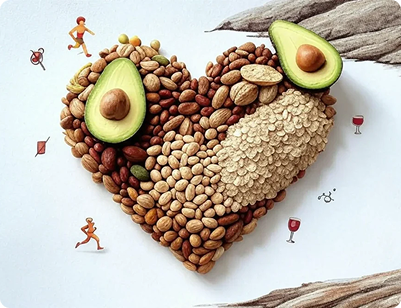
Understanding Cholesterol: A Comprehensive Guide to Heart Health
Share
Cholesterol comes in different forms, and not all of them are created equal. Here’s the breakdown:
● LDL (Low-Density Lipoprotein): AKA the “bad guy.” Too much LDL can lead to plaque buildup in your arteries, making it harder for blood to flow and increasing your risk of heart disease. Yikes.
● HDL (High-Density Lipoprotein): The hero we all need. HDL swoops in to clean up LDL by carrying it to your liver, where it gets processed and removed from your body. High-five, HDL!
● Triglycerides: These are another type of fat in your blood. When levels get too high (thanks, sugar overload), they can team up with LDL to wreak havoc on your heart health.
When LDL is too high or HDL is too low, it can lead to atherosclerosis —a fancy term for artery clogging. This narrowing and hardening of your arteries can set the stage for heart attacks, strokes, and other not-so-fun conditions. Scary stuff, but totally manageable with the right approach.
What’s Messing with Your Cholesterol?
Before we dive into fixes, let’s talk about what might be throwing your cholesterol out of whack:
● Genetics: Some people are born with a predisposition to high cholesterol. Thanks, DNA.
● Diet: Love your fried snacks and buttery everything? Saturated fats, trans fats, and processed junk can spike LDL levels faster than you can say “cheeseburger.”
● Lifestyle Choices: Sitting on the couch binge-watching shows while sipping sugary drinks? Sedentary habits, smoking, and overdoing alcohol don’t do your cholesterol any favors.
● Age & Gender: Cholesterol tends to creep up as you age. Women often see a jump post-menopause, so keep an eye on those numbers.
● Health Conditions: Diabetes, high blood pressure, and obesity can make cholesterol problems worse. Double whammy alert.
Eat Smart, Live Strong: Foods That Fight Cholesterol
Your plate is your first line of defense. Here’s how to build a cholesterol-crushing menu:
1️⃣ Swap Bad Fats for Good Ones
Say goodbye to saturated and trans fats (we’re looking at you, fast food). Instead, load up on:
● Monounsaturated fats: Think olive oil, avocados, and nuts. They’re like a warm hug for your heart.
● Polyunsaturated fats: Omega-3 fatty acids (found in flaxseeds and walnuts) are your BFFs for lowering LDL and triglycerides while boosting HDL.
2️⃣ Fiber Up
Fiber is the unsung hero of cholesterol management. Aim for 25-30 grams a day, focusing on:
● Soluble fiber: Oats, beans, lentils, fruits, and veggies help trap cholesterol in your digestive system so it doesn’t get absorbed.
● Insoluble fiber: Whole grains and veggies keep your gut happy, which indirectly supports healthy cholesterol levels.
3️⃣ Plant Power
Plant sterols and stanols are natural compounds found in fruits, veggies, and whole grains. They block cholesterol absorption, and foods fortified with them (like certain margarines) can give you an extra edge.
4️⃣ Functional Foods FTW
Some foods go above and beyond for your heart:
● Nuts: Almonds, walnuts, and pistachios are packed with healthy fats and fiber that lower LDL.
● Seeds: Flaxseeds and chia seeds bring the omega-3s and fiber to support your cholesterol game.
● Garlic: Not just for warding off vampires—garlic helps lower LDL and supports overall heart health.
5️⃣ Cut the Sugar and Processed Junk
Sugar and refined carbs are sneaky culprits behind high triglycerides and insulin resistance. Ditch the soda, pastries, and chips, and watch your cholesterol (and energy levels) improve.
Move More, Stress Less: Lifestyle Hacks for Healthy Cholesterol
Food isn’t the only player here. Your daily habits matter a lot. Here’s how to level up:
Get Moving
Exercise is like a magic pill for cholesterol. It boosts HDL, lowers LDL, and helps you
shed excess weight. Aim for at least 30 minutes of moderate cardio (walking, cycling, dancing—it’s all good!) most days of the week.
Quit Smoking, Limit Alcohol
Smoking tanks your HDL levels and damages your arteries. Alcohol, when consumed in excess, spikes triglycerides and blood pressure. Quitting smoking and moderating your booze intake can work wonders for your heart.
Supplements That Support
If you’re looking for an extra boost, supplements can help – but choose wisely. Many
focus on natural extracts and omega-3s, which are great for overall health but may not
directly lower cholesterol. Look for products with plant sterols, which studies show can
reduce LDL by up to 33% when combined with a healthy diet and exercise. Always
check with your doctor before starting anything new.
FAQs: Your Burning Questions Answered
Q: What exactly is cholesterol, and why does it matter?
A: Cholesterol is a fatty substance your body uses to make hormones, vitamin D, and bile acids. While it’s essential, too much “bad” cholesterol (LDL) can clog your arteries and increase your risk of heart disease.
Q: What foods can help lower cholesterol?
A: Load up on fiber-rich foods like oats, beans, and fruits, plus healthy fats from avocados and nuts. Plant sterols and functional foods like garlic and flaxseeds also pack a punch.
Q: How does exercise help manage cholesterol?
A: Regular movement boosts HDL (“good” cholesterol), lowers LDL, and helps you
maintain a healthy weight—all key for keeping your arteries clear and your heart happy.
Q: How much fiber should I aim for?
A: Shoot for 25-30 grams of fiber daily. Focus on soluble fiber (oats, beans, fruits) to
bind cholesterol and prevent absorption and insoluble fiber (whole grains, veggies) for
digestive health.
The Takeaway
Managing cholesterol isn’t about deprivation—it’s about making smarter choices that fuel your body and protect your heart. With a balanced diet, regular exercise, and mindful lifestyle tweaks, you’ve got this. And hey, Nature Fuel’s got your back every step of the way.
So grab that avocado toast, lace up your sneakers, and show your heart some love. Because a healthier you starts today.
